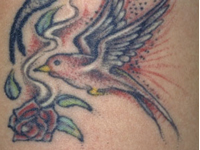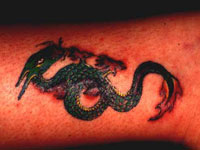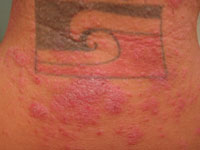What is Tattoo-associated skin reactions?
Decorative tattooing has been practised for thousands of years. In primitive times it was used for embellishment, whilst in some customs and cultures tattooing represented a sign of distinction or social rank. This remains the case today with some cultures; however, it has also become popular with everyday people of western countries in the last 10-20 years.
With the rise in number of people with tattoos in today's society, an increase in the number of tattoo-associated skin disorders can be expected. Reactions that may occur include acute inflammatory reactions, eczematous hypersensitivity reactions, photo-aggravated reactions, granulomatous reactions, lichenoid reactions and pseudolymphomatous reactions.
Acute inflammatory reactions
This reaction is in direct response to the piercing of the skin with needles impregnated with pigment dyes prepared from metal salts. There may be transient redness and swelling of the area that disappears within 2-3 weeks. It is an expected side effect of the tattooing process.
Skin infections
Infection is not common after tattooing. The following skin infections have been reported however, emphasising the need to undergo the procedure in a clean environment using sterile equipment.
- Impetigo
- Cellulitis
- Herpes simplex
- Viral warts
- Atypical mycobacterial infection
Transmission of serious blood-borne infections may occur.
- Syphilis
- Leprosy
- Viral hepatitis
- Human immunodeficiency virus (HIV)
Eczematous hypersensitivity reactions
The two most common hypersensitivity reactions to tattoo pigments are allergic contact dermatitis and photoallergic dermatitis. The reaction usually appears as an inflamed red rash or may sometimes be scaly and flaky (exfoliative dermatitis). Red tattoo pigments cause the most reactions, particularly those made from mercury sulfide (cinnabar). Hypersensitivity reactions to pigments used to make black, blue, purple and green tattoos are much less common.
The components of tattoo ink are difficult to determine and undergo changes with time. There are no regulations for tattoo inks or colour additives, which contain inorganic pigments and carbon black, and/or organic pigments from various chemical classes. The table below lists some agents that have been used. There are many more.
| Colour | Composition |
| Red |
|
| Black |
|
| Brown |
|
| Blue |
|
| Green |
|
| Yellow |
|
| Purple |
|
| White |
|
Contact dermatitis has also been reported in people with henna tattoos. Henna tattoos are non-permanent tattoos where henna dye is painted onto the skin with an artist's brush resulting in a brownish stain. Henna itself should be safe, but the dye is often mixed with paraphenylenediamine (PPD), a chemical substance that is well known for causing allergic reactions in people sensitive to it. In this case the dye is black in colour, so-called black henna
.
 |
 |
 |
Photo-aggravated reactions
Yellow tattoos created from cadmium sulfide are at most risk of causing hypersensitivity reactions when they are exposed to sunlight. Swelling and redness develop around the tattoo site. This phototoxic reaction caused by cadmium sulfide can also occur in red tattoos, as trace amounts of cadmium are added to brighten red tattoo pigment.
Granulomatous reactions
The term granuloma refers to the particular kind of cells that cause the reaction. A foreign body reaction to pigment may cause raised red bumps at the site of the tattoo that are made up of epithelioid cells, lymphocytes and a few giant cells. Most commonly red, but also, green, blue and purple pigment tattoos, and UV-visible tattoos have been associated with granulomatous reactions.
Lichenoid reactions
These types of reactions are much less common than eczematous hypersensitivity reactions. Their signs and symptoms are the same as those in lichen planus, although the reaction is usually confined to the red parts of the tattoo. Hence, red pigment is responsible for most lichenoid tattoo reactions.
Pseudolymphomatous reactions
These are usually the result of a delayed hypersensitivity reaction to tattoo pigment. Again, red pigment is the main cause but it has also been reported with green and blue pigments. Pseudolymphomas caused by tattoo pigment are characteristically plum to red coloured nodules and plaques. They need to be clinically distinguished from cutaneous lymphomas that may be the cause of serious malignant conditions.
Keratoacanthoma-like reactions to tattoos have also been described.
Removal of tattoos
Tattoos are most often treated with Q-switched lasers. In most cases, 5 to 12 treatments are required, at 6 to 8-week intervals. Complete clearance is not always possible.
The laser may be selected according to the colour of the tattoo pigment:
- Nd:YAG (1064 nm) for black and blue pigment
- Alexandrite (755nm) for black, blue and green pigment
- Ruby (694nm for black, blue and green pigment
- Frequency doubled Nd:YAG (532 nm) for red, orange and purple pigment
- Flashlamp-pumped pulsed dye (510 nm) for red, purple, orange and yellow pigment
White and yellow pigment appears to be the most difficult to eradicate. Complications may include:
- Scarring
- Unwanted colour changes including darkening of tattoo e.g. brown to black (ferric oxide becomes ferrous oxide)
- Spreading of allergic reaction as tattoo granules disperse
Alternatively, ablative fractional resurfacing can be used.
